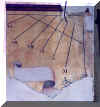
CASTLES

At the entrance to the Ayas Valley, tourists are struck by the image of Verres Castle which is the most representative defensive fort of Challant Counts. It was built in 1390 by Ibleto of Challant will. The impressive structure of this castle has no comparison in any other medieval building in the Aosta Valley.

Along Ayas Valley road, in brusson, it is possible to admire the ruins of another castle that belonged to Challant Counts: Graines Castle, which was the administrative and summer residence of the family.
THE
WALSER POPULATION IN AYAS VALLEY
It is now understood that in 800-900 a.C.
the Germanic population of the alemanns settled in the upper part of the vallais,
where they grouped together and gave birth to what became known as the great
walser community.
Poverty of the lands situated in the upper rhone valley
and the increase in population, forced some groups of people from the vallais (WALLISER,
later contracted into Walser) to leave and colonized unexploited lands. From
1200-1300 a.C. they set off once more. Contrary to the previous en masse
migrations, this time they moved in small groups along the highest alpine
valleys and settled in the most impractical areas discarded by the locals.
As soon as the new settlement improved and the dried
lands bore the first fruits, new groups arrived. gradually, in different waves,
the Walser population spread all over the Alps, from the Aosta Valley to
Vorarlberg and the western limits of Austria. The areas where they established
themselves were situated in the highest regions of the Alps, abandoned by
previous populations who were unable to exploit the land and settled in the
lower part of the valleys.
Walser people were forced to migrate for economic
reasons. However, we cannot ignore their charcteristics of free men, loving
adventure and conquest. Their lives in inhospitable lands were not easy. The
only resorts were breeding and farming mountain pastures to feed animals during
the long winter. They were compelled to trade with local neighbours to get what
they were unable to produce by themselves. Nevertheless, the Walser population
progressed and spread. Their presence was welcome also by the lords who owned
the lands, since they received a high rent. Moreover the walser people were
experts on arms and could grant the lord a reliable base for recruiting militia.
As far as the Val d’ossola, Val Sesia and Aosta
Valleys are concerned, the Walser migrations can be summarised as follows:
- through the gries pass they went down in the upper Valle del Toce
- From the Sempione pass they went down simplon and grondo
- through the Monte Moro pass they
founded Macugnaga
- Ayas and Gressoney were founded by populations coming from Colle del Teodulo.
According to other versions -more
fanciful than historical- Walsers
crossed the Colle Del Lys whilst it was not covered with snow. Then glaciation
made it impossible to follow such a path and the walser people were prevented
from communicating with their countries of origin. this created the legend of
the lost valley ( "das Verlorne thal") that was thought to be beyond
Mont Rose. The legend tells that the valley was rich in pastures for cattle and
thick forests with a lot of wild animals.
- the colonies of Alagna, Riva Valdobbia, Rima, Rimella were founded by Walsers
from Gressoney (through the Col d’Olen) and from Macugnaga (through the Passo
del Turlo).
Walser Expansion seems to have reached its height between 1400- 1500.
in the Ayas valley, there are a lot of signs testifying to walser presence: in architecture, language, villages naming and the traditional ayas dress.
Here, at the head of champoluc, they founded “le canton des Allemands (The German Corner), a settlement of about 500 people.
The place known today as St. Jacques was the centre of this settlement, so that the complete name at that time was Saint Jacques des allemands (Saint Jacques of Germans).
The
interest of the walser people to this land is found in the richness of a stone
which is particularly malleable (known as “pera doutsa”, mild stone) that
was used to produce domestic pans.
In addition to the colonisation of the central valley, Walsers also Founded villages at higher altitudes, between 1900 and 2075 metres (For instance, Mascognaz, cuneaz and crest). Among them, the highest is Resy.
In spite of the altitude, these settlements were inhabited all year long
and were amongst the Highest Permanent inhabited villages in Europe.
LEGENDS
Resy
hermit
A
shepherd hermit was living in a hut in the forest. He used to eat berries and
drink milk, talk with his sheep and felt that the Lord was close to him. He
would have liked to know how to pray with appropriate words as priests did, but
nobody had ever taught him.